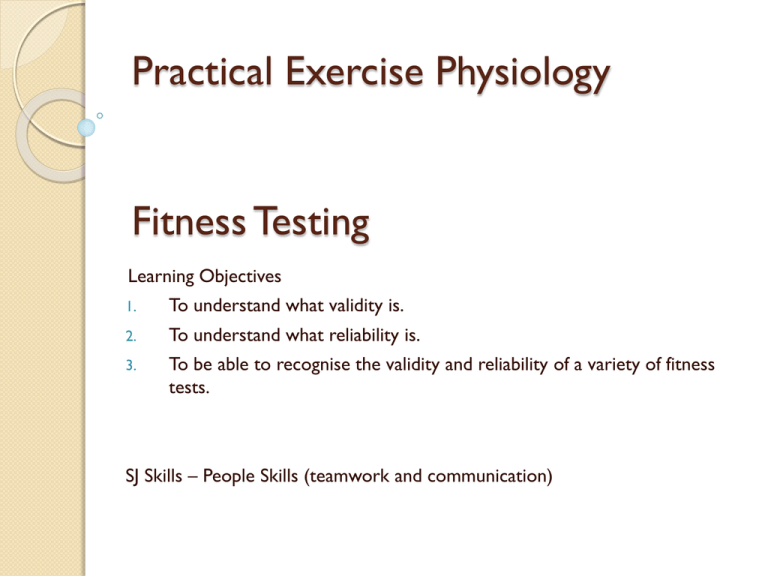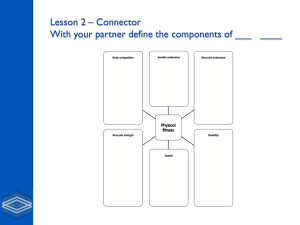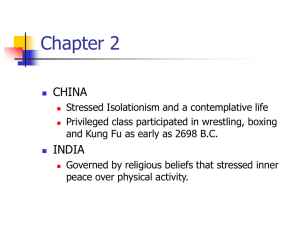Fitness Testing - PE Course Specification
advertisement

Practical Exercise Physiology Fitness Testing Learning Objectives 1. To understand what validity is. 2. To understand what reliability is. 3. To be able to recognise the validity and reliability of a variety of fitness tests. SJ Skills – People Skills (teamwork and communication) Test Validity To be valid, a test must assess what it is intending to. Is the test specific for your sport? Is it relevant? Is it too general? Does it only test the fitness component that it is meant to? Are there other factors involved? Test Reliability The test must give the same result if repeated. Essential for fitness tests because it shows that improvements are due to increased fitness levels. A difference of +/- 5% is expected. Over 10% suggests the test is unreliable. Fitness Tests Task: working in groups of 3 you are going to participate in a number of fitness tests. As a group you need to complete every test whilst also considering the validity and reliability of these tests in relation to your sport. Multi-Stage Fitness Test Fitness Component: stamina. Procedure: Complete the 20m shuttle runs in time with the ‘bleeps.’ If you arrive early at the end of a shuttle, you must wait for the bleep before resuming running. Continue until you are physically unable to. Missing one bleep is fine, but two in a row means you are out. Record score of level and sub level completed (e.g. 8.2). Grip Dynamometer Fitness component: strength Procedure: Hold grip dynamometer above head with straight arm. Squeeze as you bring the dynamometer down to your side. Record score and repeat 3 times. Sit and Reach Test Fitness component: flexibility. Procedure: Sit with straight legs up against the bench. Reach fingers forward and hold. Measure from the ‘bobbles on bench.’ If fingers are past this point give a ‘+ score’, if behind a ‘– score.’ Repeat 3 times. Standing Broad Jump Fitness Component: Power Procedure: Stand with both feet behind line. Two footed jump as far as possible. Measure from the back of the feet. Record score and repeat 3 times. 20m Sprint Test Fitness component: Speed Procedure: Work with a partner. Sprint the 20m track whilst partner times with stopwatch. Repeat 3 times. Stork Stand Fitness Component: Balance Procedure: Work with partner. Place foot on line. Bring other leg up so that it is flat against side of knee of standing leg. Close eyes (partner start stopwatch when eyes close). Stop time if eyes open, balancing foot leaves line, or other foot comes away. 45s max. Repeat 3 times. Anderson Ball-Catch Test Fitness Component: Coordination Procedure: Work with partner. Stand 2m from wall with tennis ball. Throw underarm with one hand, catch with the other. Partner uses stopwatch and counts to record how many successful catches are completed in 30s. A dropped ball does not mean that the test stops or the scores reset, only that you do not score for that throw. Repeat 3 times. Ruler Test Fitness Component: reaction time. Procedure: Work with partner. Partner holds ruler whilst you place thumb and forefinger either side of 30cm mark. Partner drops ruler without warning and you must catch as quickly as possible. Record the score (30cm be the highest possible score, indicating an immediate catch). Repeat 3 times. Test Results, Reliability and Validity Test Multi-Stage Fitness Test Grip Dynamometer Sit and Reach Test Standing Broad Jump 20m Sprint Test Stork Stand Anderson Ball-Catch Test Ruler Test 1 2 3 Reliability Validity Results Discuss as a group the reliability and validity of the tests that you completed. Remember to state why you felt the test was/was not reliable or valid. What factors affect whether or not a test is reliable or valid? Could a test have been reliable or valid for some in the group but not for others? Exam Question You are asked to assess the strength and reactions of a tennis player using the grip dynamometer and ruler tests. Explain how suitable these tests are in this situation in terms of their reliability and validity. (6 marks) Answer (mark your own) Grip dynanometer not specific to tennis (the movement does not occur in tennis). Whilst strength is important in tennis, hand grip strength is not necessarily essential. Does not assess strength of any other areas of the body. Results gained through grip dynanometer are generally reliable but not appropriate. Ruler test not specific to tennis (this type of reaction does not occur in tennis). Whilst quick reactions are essential in tennis, it is a reaction of the whole body and not just the fingers that is important. Results gained through the ruler test are often unreliable as there is great variation on repeated attempts.









